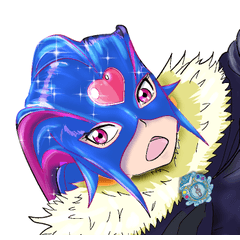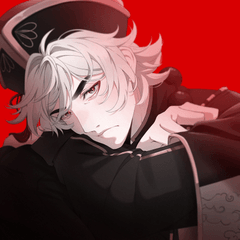6. Painting (Gold decorations, Japanese patterns)
[1] Gold decorations
Here, I add colors with the [Brush] tool > [Opaque watercolor] sub tool.
① Bright base colors are good, as they make highlights look better. (Brighter colors might have been better here...)
② I block in rough shadows from here.
③ I draw detailed shadows.
④ I add darker shadows using the pencil mainly.
⑤ I combine layers set to [Multiply] in ②-④, and add highlights with a transparent [Pencil] tool.
I think the highlights should be strong too.
⑥ I create a layer set to [Screen] above the layer and add reflections.
For the metal parts, I try to keep the contrast high. Sections where the light hits are pale, almost white, and the shadows are extra dark.
[2] Japanese patterns
As before, I used the [Brush] tool -> [Opaque watercolor] sub tool.
① The base layer.
② Place rough shadows.
③ Shadows with cloth layers and light source in mind.
④ Add shadows to places where the cloth overlap.
⑤ Cloth wrinkles.
⑥ Paste and adjust apanese pattern materials with [Edit] > [Transform] to fit the cloth's wrinkle and flow.
To reflect the wrinkle’s shadow, I place the layer created in ⑥ between ③ and ④.
Layers are arranged as shown below.
Note:
Redrawing Japanese patterns is time consuming, so I make materials like the image below now and then.
I used these three for this piece. I open the material in a separate window and click [Layer] menu > [Selection from Layer] > [Create Selection]. Then, I copy the selection to the clipboard with [Edit] menu > [Copy]. Returning to the work file and pasting with [Edit] menu -> [Paste], the material is edited after clipping it to the base layer with [Clip at Layer Below].
[3] Flower decoration pattern
I’ve been using this Hitta pattern for a while now.
I select [Window] menu > [Material] > [Material [Monochromatic pattern]], to display the [Material] palette.
After clicking [Show Menu] in the upper left of the material palette, I select [Register Image as Material].
I add and register the following settings in the [Material Property] dialog box.
“Hitta pattern” is registered to the [Material] palette as an [Image Material].
I select the target area’s base layer, and create a selection area with [Layer] menu > [Selection area] > [Create Selection].
From the material palette, I past the “Hitta pattern” image material by dragging the material onto the canvas.
The Hitta pattern now has a color.
On an [Image material layer], you cannot color using tools such as [Watercolor].
I right-click the [Layer Mask] thumbnail of the image material Layer(①), and select [Apply Mask to Layer].
I press [OK] in the dialog box shown below, apply the layer mask, and convert the [Image Material Layer] to a [Raster Layer]. The layer can now be colored.
I turn the [Layer] palette [Lock Transparent Pixel] on, and paint the drawn parts white.
After erasing the edge patterns, I repeat the same procedure as “[2] Japanese pattern costume”.
Other patterns are added by repeating this procedure, and the characters are completed!
Layers are sorted into folders based on each character. For each layer folder, I select the character’s layer folder and right click > [Merge selected layers].
























Comment